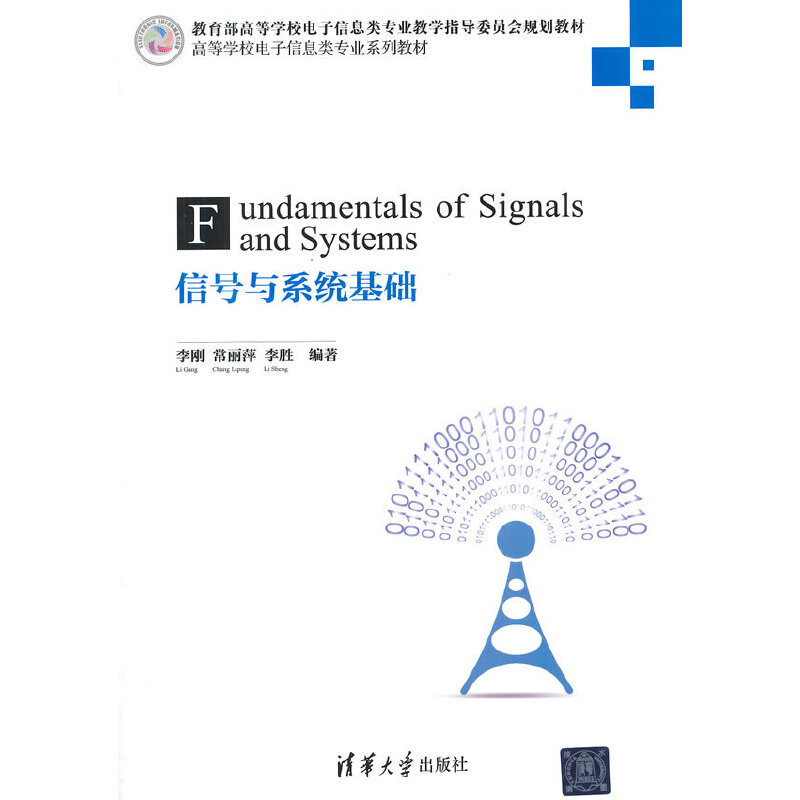信号与系统基础 / 高等学校电子信息类专业系列教材
定价:¥36.00
作者: 李刚、常丽萍主编
出版时间:2015年1月
出版社:清华大学出版社
- 清华大学出版社
- 9787302385981
- 1-1
- 156492
- 16开
- 2015年1月
- TN911.6
- 电工电子
- 高职高专
目录
1.4.3 Invertibility
1.4.4 Stability
1.4.5 Time-invariance
1.4.6 Linearity
1.5 Summary
1.6 Problems
Chapter 2 Time-domain Analysis of LTI Systems
2.1 Introduction
2.2 The unit impulse response and convolutions
2.2.1 The convolution sum ~
2.2.2 The convolution integral
2.3 Properties of convolutions and equivalent systems
2.4 Causality and stability of LTI systems
2.5 Systems constrained with LCCDEs
2.5.1 Continuous-time systems constrained with LCCDEs
2.5.2 Discrete-time systems characterized by LCCDEs
2.6 Summary
2.7 Problems
Chapter 3 Fourier Analysis of Signals
3.1 Introduction
3.2 Fourier series for continuous-time periodic signals
3.3 Fourier series for discrete-time periodic signals
3.4 Why should a signal be transformed?
3.5 Fourier transform for continuous-time signals
3.5.1 Properties of Fourier transform
3.5.2 Inverse Fourier transform
3.6 The discrete-time Fourier transform
3.6.1 Properties of DTFT
3.6.2 Inverse DTFT
3.7 Fourier series and Fourier transforms
3.8 Summary
3.9 Problems
Chapter 4 Frequency-domain Approach to LTI Systems
4.1 Introduction
4.2 Frequency response of LTI systems
4.3 Bode plots for continuous-time LTI systems
4.4 Frequency response of LTIs described with LCCDEs
4.5 Frequency domain approach to system outputs
4.6 Some typical LTI systems
4.6.1 All-pass systems
4.6.2 Linear phase response systems
4.6.3 Ideal filters
4.6.4 Ideal transmission channels
4.7 Summary
4.8 Problems
Chapter 5 Discrete Processing of Analog Signals
5.1 Introduction
5.2 Sampling of a continuous-time signal
5.3 Spectral relationship and sampling theorem
5.4 Reconstruction of continuous-time signals
5.5 Hybrid systems for discrete processing
5.6 Discrete Fourier transform
5.7 Compressed sensing
5.8 Summary
5.9 Problems
Chapter 6 Transform-domain Approaches
6.1 Motivation
6.2 The Laplace transform
6.2.1 Derivation of the transform
6.2.2 Region of convergence
6.2.3 Inverse Laplace transform
6.2.4 Properties of Laplace transform
6.3 The z-transform
6.3.1 Region of convergence
6.3.2 Properties of the z-transform
6.3.3 Inverse z-transform
6.4 Transform-domain approach to LTI systems
6.4.1 Transfer function of LTI systems
6.4.2 Inverse systems of LTIs and deconvolutions
6.4.3 Revisit of LTI system's stability and causality
6.4.4 Transfer function of LTI systems by LCCDEs
6.5 Transform domain approach to LCCDEs
6.6 Decomposition of LTI system responses
6.7 Unilateral transforms
6.7.1 Unilateral Laplace transform
6.7.2 Unilateral z-transform
6.8 Summary
6.9 Problems
Chapter 7 Structures and State-space Realizations
7.1 Block-diagram representation
7.2 Structures of LTIs with a rational transfer function
7.3 State-space variable representation
7.3.1 State model and state-space realizations
7.3.2 Construction of an equivalent state-space realization
7.3.3 Similarity transformations
7.4 Discretizing a continuous-time state model
7.5 Summary
7.6 Problems
Chapter 8 Comprehensive Problems
8.1 Motivation
8.2 Problems
Appendices
Bibliography
1.4.4 Stability
1.4.5 Time-invariance
1.4.6 Linearity
1.5 Summary
1.6 Problems
Chapter 2 Time-domain Analysis of LTI Systems
2.1 Introduction
2.2 The unit impulse response and convolutions
2.2.1 The convolution sum ~
2.2.2 The convolution integral
2.3 Properties of convolutions and equivalent systems
2.4 Causality and stability of LTI systems
2.5 Systems constrained with LCCDEs
2.5.1 Continuous-time systems constrained with LCCDEs
2.5.2 Discrete-time systems characterized by LCCDEs
2.6 Summary
2.7 Problems
Chapter 3 Fourier Analysis of Signals
3.1 Introduction
3.2 Fourier series for continuous-time periodic signals
3.3 Fourier series for discrete-time periodic signals
3.4 Why should a signal be transformed?
3.5 Fourier transform for continuous-time signals
3.5.1 Properties of Fourier transform
3.5.2 Inverse Fourier transform
3.6 The discrete-time Fourier transform
3.6.1 Properties of DTFT
3.6.2 Inverse DTFT
3.7 Fourier series and Fourier transforms
3.8 Summary
3.9 Problems
Chapter 4 Frequency-domain Approach to LTI Systems
4.1 Introduction
4.2 Frequency response of LTI systems
4.3 Bode plots for continuous-time LTI systems
4.4 Frequency response of LTIs described with LCCDEs
4.5 Frequency domain approach to system outputs
4.6 Some typical LTI systems
4.6.1 All-pass systems
4.6.2 Linear phase response systems
4.6.3 Ideal filters
4.6.4 Ideal transmission channels
4.7 Summary
4.8 Problems
Chapter 5 Discrete Processing of Analog Signals
5.1 Introduction
5.2 Sampling of a continuous-time signal
5.3 Spectral relationship and sampling theorem
5.4 Reconstruction of continuous-time signals
5.5 Hybrid systems for discrete processing
5.6 Discrete Fourier transform
5.7 Compressed sensing
5.8 Summary
5.9 Problems
Chapter 6 Transform-domain Approaches
6.1 Motivation
6.2 The Laplace transform
6.2.1 Derivation of the transform
6.2.2 Region of convergence
6.2.3 Inverse Laplace transform
6.2.4 Properties of Laplace transform
6.3 The z-transform
6.3.1 Region of convergence
6.3.2 Properties of the z-transform
6.3.3 Inverse z-transform
6.4 Transform-domain approach to LTI systems
6.4.1 Transfer function of LTI systems
6.4.2 Inverse systems of LTIs and deconvolutions
6.4.3 Revisit of LTI system's stability and causality
6.4.4 Transfer function of LTI systems by LCCDEs
6.5 Transform domain approach to LCCDEs
6.6 Decomposition of LTI system responses
6.7 Unilateral transforms
6.7.1 Unilateral Laplace transform
6.7.2 Unilateral z-transform
6.8 Summary
6.9 Problems
Chapter 7 Structures and State-space Realizations
7.1 Block-diagram representation
7.2 Structures of LTIs with a rational transfer function
7.3 State-space variable representation
7.3.1 State model and state-space realizations
7.3.2 Construction of an equivalent state-space realization
7.3.3 Similarity transformations
7.4 Discretizing a continuous-time state model
7.5 Summary
7.6 Problems
Chapter 8 Comprehensive Problems
8.1 Motivation
8.2 Problems
Appendices
Bibliography










